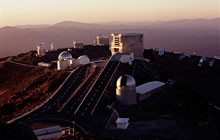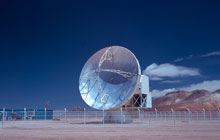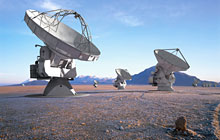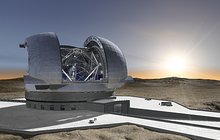Telescopen en instrumentatie
Zoals in haar oprichtingsverdrag is vastgelegd, voorziet ESO Europese astronomen van moderne onderzoeksfaciliteiten, en bevordert en organiseert zij astronomische samenwerkingsverbanden. ESO beheert enkele van de grootste en meest geavanceerde waarneemfaciliteiten ter wereld: La Silla, Paranal en Chajnantor – alle drie in het noorden van Chili. Ze behoren tot de beste waarneemlocaties op het zuidelijk halfrond. Dankzij andere activiteiten, zoals de ontwikkeling van technieken en het organiseren van conferenties en educatieve projecten, speelt ESO ook een doorslaggevende rol bij de totstandkoming van een Europese Onderzoeksruimte voor sterrenkunde en astrofysica.
Paranal-sterrenwacht
 De Very Large Telescope (VLT) op Cerro Paranal is ESO’s belangrijkste instrument voor waarnemingen in zichtbaar en infrarood licht. De vier 8,2-meter Unit Telescopes (UTs) met hun grote collectie instrumenten, worden doorgaans afzonderlijk gebruikt.
De Very Large Telescope (VLT) op Cerro Paranal is ESO’s belangrijkste instrument voor waarnemingen in zichtbaar en infrarood licht. De vier 8,2-meter Unit Telescopes (UTs) met hun grote collectie instrumenten, worden doorgaans afzonderlijk gebruikt.
De VLT biedt echter ook de mogelijkheid om het licht van de vier afzonderlijke telescopen te combineren, zodat ze als een interferometer werken. Deze Very Large Telescope Interferometer (VLTI), die zijn eigen verzameling instrumenten heeft, zal uiteindelijk beelden met een resolutie van enkele duizendsten van een boogseconde opleveren, en astrometrisch onderzoek met een nauwkeurigheid van 10 microboogseconden mogelijk maken. Behalve de 8,2-meter telescopen gebruikt de VLTI ook de vier 1,8-meter Auxiliary Telescopes (AT's), die de beeldkwaliteit verbeteren en ervoor zorgen dat het hele jaar door de gehele nacht kan worden waargenomen.
Op Paranal wordt ook gewerkt met twee zogeheten surveytelescopen: de VLT Survey Telescope (VST, middellijn 2,6 meter) voor het zichtbare golflengtegebied, en de Visible and Infrared Survey Telescope for Astronomy (VISTA, middellijn 4,1 meter) voor het infrarode bereik.
Bekijk de VLT op Google Maps. Informatie over het bezoeken van de ESO-observatoria is beschikbaar op een aparte pagina.
La Silla-sterrenwacht
 Op La Silla beheert ESO twee grote telescopen: de 3,6-meter ESO-telescoop en de New Technology Telescope (NTT). Ze zijn voorzien van moderne instrumenten die volledig door ESO zelf zijn gebouwd of door externe consortia met een aanzienlijke bijdrage van ESO.
Op La Silla beheert ESO twee grote telescopen: de 3,6-meter ESO-telescoop en de New Technology Telescope (NTT). Ze zijn voorzien van moderne instrumenten die volledig door ESO zelf zijn gebouwd of door externe consortia met een aanzienlijke bijdrage van ESO.
Bekijk La Silla op Google Maps. Informatie over het bezoeken van de ESO-observatoria is beschikbaar op een aparte pagina.
APEX
 APEX, de Atacama Pathfinder Experiment, is een samenwerkingsproject van het Max Planck-Instituut voor Radiosterrenkunde (MPIfR; 55%), het Onsala Ruimteobservatorium (OSO; 13%) en de Europese Zuidelijke Sterrenwacht (ESO; 32%). Het betreft een aangepast prototype van de schotelantennes die voor de ALMA-array worden gebruikt, die zich op 5100 meter hoogte op de Chajnator-hoogvlakte bevindt. De telescoop is geleverd door VERTEX Antennentechnik in Duisburg (Duitsland). APEX beschikt over een aantal heterodyne spectrometers en groothoek-bolometercamera's die gevoelig zijn voor de atmosferische golflengtevensters tussen 0,2 en 1,4 mm. De telescoop wordt beheerd door ESO.
APEX, de Atacama Pathfinder Experiment, is een samenwerkingsproject van het Max Planck-Instituut voor Radiosterrenkunde (MPIfR; 55%), het Onsala Ruimteobservatorium (OSO; 13%) en de Europese Zuidelijke Sterrenwacht (ESO; 32%). Het betreft een aangepast prototype van de schotelantennes die voor de ALMA-array worden gebruikt, die zich op 5100 meter hoogte op de Chajnator-hoogvlakte bevindt. De telescoop is geleverd door VERTEX Antennentechnik in Duisburg (Duitsland). APEX beschikt over een aantal heterodyne spectrometers en groothoek-bolometercamera's die gevoelig zijn voor de atmosferische golflengtevensters tussen 0,2 en 1,4 mm. De telescoop wordt beheerd door ESO.
ALMA
 De Atacama Large Millimeter/submillimeter Array (ALMA) is een internationaal samenwerkingsverband. Dat heeft een telescoop ontwikkeld met een revolutionair ontwerp, waarmee het universum wordt bestudeerd vanuit de Chileense Andes. ALMA bestaat uit 66 zeer precieze schotelantennes die gevoelig zijn voor golflengten van 0,32 tot 3,6 mm. De hoofdarray zal bestaan uit vijftig antennes met een diameter van 12 meter, die als één telescoop werken – een interferometer. Deze wordt aangevuld met een compacte array van vier 12-meter en twaalf 7-meter antennes. De ALMA-antennes kunnen in verschillende configuraties worden opgesteld, waarbij de maximale afstand tussen de antennes kan variëren van 150 meter tot 16 kilometer. De ALMA-correlator, een speciale computer die de informatie die de antennes ontvangen combineert, kan een opmerkelijke 16.000 miljoen-miljoen (1,6x1016) berekeningen per seconde uitvoeren.
De Atacama Large Millimeter/submillimeter Array (ALMA) is een internationaal samenwerkingsverband. Dat heeft een telescoop ontwikkeld met een revolutionair ontwerp, waarmee het universum wordt bestudeerd vanuit de Chileense Andes. ALMA bestaat uit 66 zeer precieze schotelantennes die gevoelig zijn voor golflengten van 0,32 tot 3,6 mm. De hoofdarray zal bestaan uit vijftig antennes met een diameter van 12 meter, die als één telescoop werken – een interferometer. Deze wordt aangevuld met een compacte array van vier 12-meter en twaalf 7-meter antennes. De ALMA-antennes kunnen in verschillende configuraties worden opgesteld, waarbij de maximale afstand tussen de antennes kan variëren van 150 meter tot 16 kilometer. De ALMA-correlator, een speciale computer die de informatie die de antennes ontvangen combineert, kan een opmerkelijke 16.000 miljoen-miljoen (1,6x1016) berekeningen per seconde uitvoeren.
ALMA is in 2013 geïnaugureerd, maar de eerste wetenschappelijke waarnemingen met een deel van de array werden al in 2011 uitgevoerd.
ALMA is een samenwerking van ESO (namens haar lidstaten), NSF (VS) en NINS (Japan), samen met NRC (Canada), NSC en ASIAA (Taiwan), en KASI (Zuid Korea), met medewerking van de Republiek Chili. Het gezamenlijke ALMA Observatory wordt beheerd door ESO, AUI/NRAO en NAOJ.
Meer informatie over deze telescoop is te vinden op de ALMA-pagina. Informatie over het bezoeken van de ESO-observatoria is beschikbaar op een aparte pagina.
ELT
 ESO werkt samen met zijn gebruikersgemeenschap van Europese astronomen en astrofysici aan het ontwerp van de nieuwe reuzentelescoop die medio volgend decennium nodig is: de Extremely Large Telescope (ELT). De ELT zal de grootste optische/nabij-infraroodtelescoop ter wereld zijn – het 'grootste oog op de hemel'. De spiegel is bijna zo groot als een half voetbalveld.
ESO werkt samen met zijn gebruikersgemeenschap van Europese astronomen en astrofysici aan het ontwerp van de nieuwe reuzentelescoop die medio volgend decennium nodig is: de Extremely Large Telescope (ELT). De ELT zal de grootste optische/nabij-infraroodtelescoop ter wereld zijn – het 'grootste oog op de hemel'. De spiegel is bijna zo groot als een half voetbalveld.
De bouw van de ELT begon eind 2014 gepland. De eerste waarnemingen worden rond 2024 verwacht.
De locatie van de ELT is Cerro Armazones, 20 kilometer van de Paranal-sterrenwacht, waar de VLT staat.
Met zijn 39-meter hoofdspiegel en adaptieve optiek kan de ELT ons begrip van het heelal revolutionair vergroten, net als de telescoop van de Italiaanse astronoom Galilei 400 jaar geleden heeft gedaan toen deze voor het eerst op de sterrenhemel werd gericht.
Meer informatie over deze telescoop is te vinden op de ELT-pagina.
Voor wetenschappers
- Meer informatie over ESO’s observatoria
- Meer informatie over toekomstige faciliteiten
